The population of the city of Cleveland has declined considerably from its peak, and as a result, they simply do not need as many school buildings as they used to. Which specific schools were chosen is an issue best addressed elsewhere by those more familiar with the issue.
According to Mr. Ott's article, five of the schools will be rebuilt on the existing sites. These include the Cleveland School of the Arts, Dunbar, and Orchard. The remaning 20 lots will likely be offered for sale.
There are also several surplus buildings Mr. Ott identifies that will be offered for sale as-is. I will address those structures in a future article.
In the past couple days, I've photographed most of the schools on the list. I hope that this provides some idea as to the visual character of the properties that our community will be losing. Those I've been unable to photograph, I've linked to photographs elsewhere.
The architects responsible for the strucures have been noted, when possible. It is also noted when a structure is a Cleveland Landmark, or if a structure has been nominated for Landmark status and the application is pending.
Phase I

Alexander Hamilton
3465 East 130th Street
Built 1928. George Martin Hopkinson, architect.
This school has some truly wonderful architectural detail. It seems a true shame that it hasn't been maintained, and that it hasn't been properly secured, allowing further damage to occur to the property.
Almira
3380 West 98th Street
Built 1916. Walter McCornack, architect.
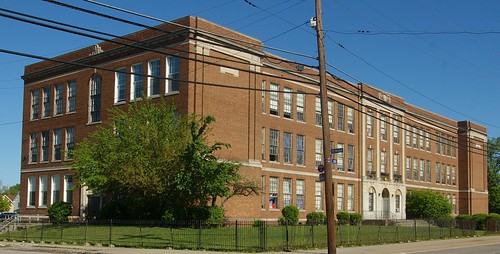
Charles Dickens
3522 East 131st Street
Built 1927. George Martin Hopkinson, architect.
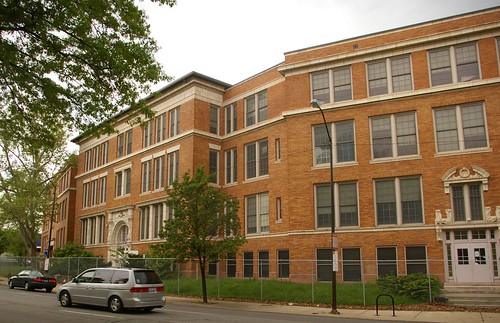
Cleveland School of the Arts
2064 Stearns Road
Built 1901.
The terra cotta on this building is some of the most impressive architectural detail on any of the Cleveland schools. It is also home to one of my favorite pieces of public art in Cleveland, this 1998 mural by Mark Howard. Here are more photos of the structure. This is one of the schools that will be rebuilt.

Louis Pasteur
815 Linn Drive
Built 1959.
This school, while not as ornate as some, still has good lines. It has a main entrance on Linn Drive.

Miles
11918 Miles Avenue
Built 1912. Third floor added 1918. Rear wing added 1971.
This is another school that, while likely in poor condition, has suffered due to a failure to secure the property. This includes both the original building, and the 1971 addition.
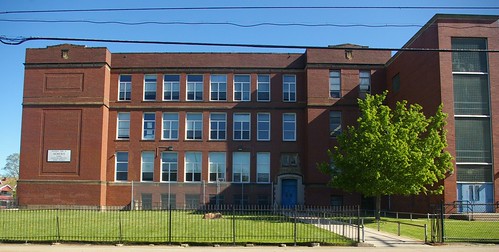
Mount Pleasant
11617 Union Avenue
Built 1913. Frank Seymour Barnum, architect.
Third story addition, 1918. Walter McCornack, architect.
Mount Pleasant features an interesting, if perhaps not quite so grand as some others, entrance facing East 116th Street. It also includes a later brick addition.
Orchard
4200 Bailey Avenue
Built 1962.
Orchard was one of several schools built quickly and to a low standard during the 1960s. It is set to be replaced by a new building. I hope, at the very least, that the wrought iron fence designed by artist Brinsley Tyrrell, which surrounds the playground and garden, can be saved.
Paul L. Dunbar
2200 West 28th Street
Built 1965.
Dunbar, also built during the 1960s, has suffered similar structural issues to Orchard. It is also set to be rebuilt.
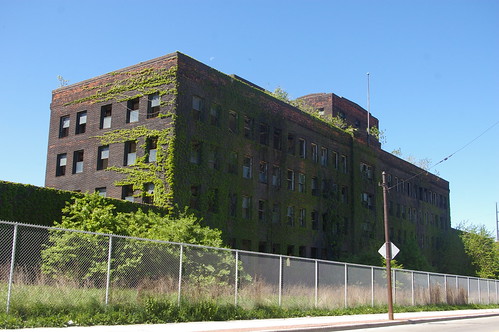
Woodhill Quincy administration center
10600 Quincy Avenue
Built 1921. Hubbell and Benes, architects.
This structure, built for National Malleable Castings, served as an administration center for a time. It has long been vacant and is in deteriorated condition.
Phase II
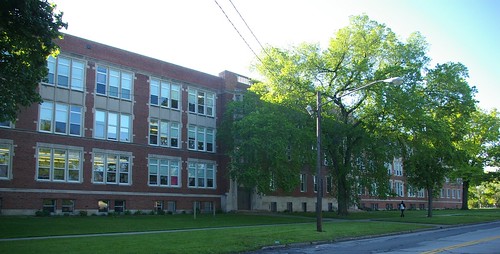
Audubon
3055 Martin Luther King, Jr. Drive.
Built 1922. Walter McCornack, architect.
This school features Gothic revival details, including around the doorways.
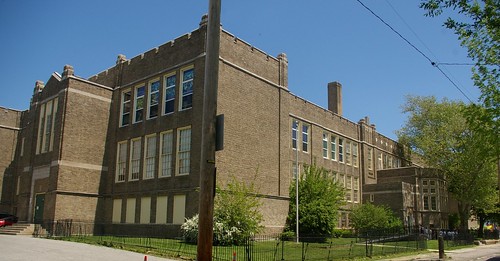
Empire CompuTech
9119 Parmalee Avenue
Built 1915. Walter McCornack, architect.
Landmark application pending
Councilman Michael Polensek called this structure "A magnificent building." He added that "It's one of the true gems in the system." It posesses significant architectural detail.
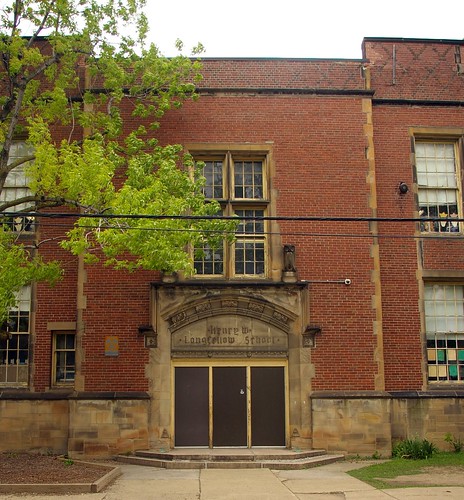
Henry W. Longfellow
650 East 140th Street
Built 1924. Walter McCornack, architect.
Landmark application pending
This school, with its heavily wooded front lawn, faces East 140th Street. The owls over the doorway look out onto the sidestreets. The rear wing and smokestack are especially impressive.
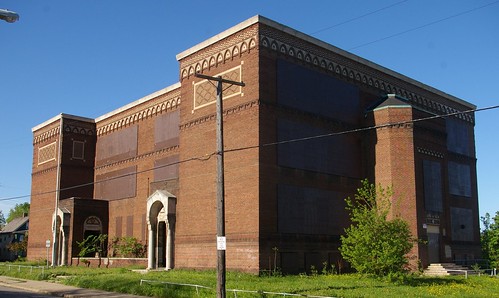
Mount Auburn
10110 Mt. Auburn Avenue
Built 1922. Walter McCornack, architect.
Cleveland Landmark
This school, with its arched doorways is both a community and city landmark.
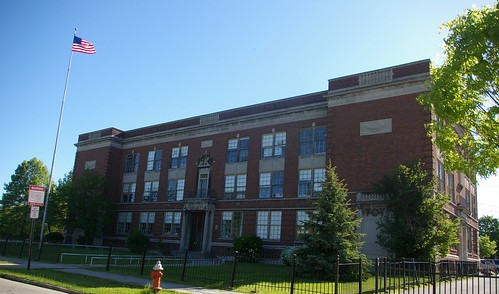
Robert K. Fulton
3291 East 140th Street
Built 1929. George M. Hopkinson, architect.
Cleveland Landmark
This school, in the Mount Pleasant neighborhood, appears on the exterior to be in good condition. A later addition shares some detail with the original.

Image used courtesy of the Cleveland Memory Project, Cleveland State University
Watterson-Lake [unused section]
1422 West 74th Street
Built 1906. Frank S. Barnum, architect.
Cleveland Landmark
The unused section that is referred to here is the entire old wing. This would be especially difficult to repurpose as it is physically attached to the school building. I've elected to use this historical image as vegetation makes it difficult to see the school right now.
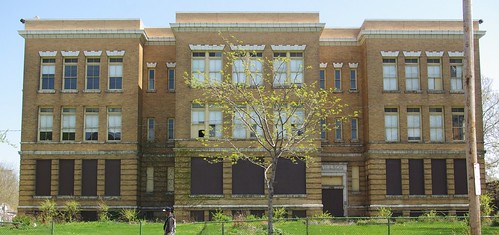
Willson
1625 East 55th Street
Built 1903. Frank S. Barnum, architect.
Cleveland Landmark
Willson was named for the street it faced, before the 1905 renaming changed it to East 55th Street.
Phase III
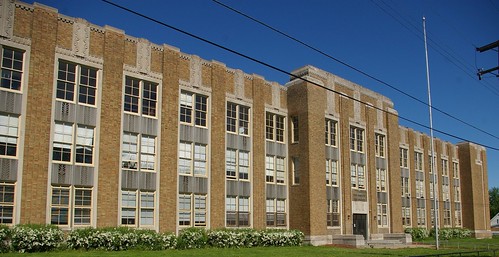
Albert B. Hart
3901 East 74th Street
Built 1932. George Martin Hopkinson, architect.
Albert Hart is one of my personal favorite structures on the demolition list. The art deco details around the main entrance are especially noteworthy. Also of interest are the metal panels between floors separating the windows.

Forest Hill Parkway
450 East 112th Street
Built 1967.
The Forest Hill Parkway campus features two round buildings overlooking a massive expanse of green. It appears to be a well designed structure, one that could be repurposed by another party that wanted to take advantage of the great location.
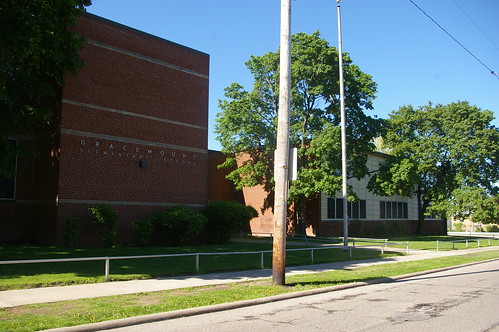
Gracemount
16200 Glendale Avenue
Built 1947.
The most notable feature of Gracemount is this multi-colored glass block wall.
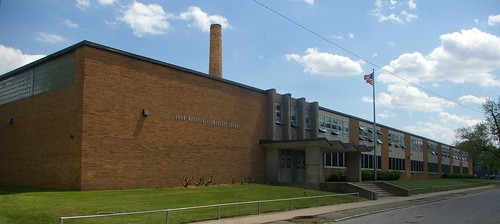
John W. Raper
1601 East 85th Street
Built 1963.
John W. Raper is the only one of these schools that I've been inside. While possessing limited architectural detail, it appears to be a solid structure that might be easily reused by another party.
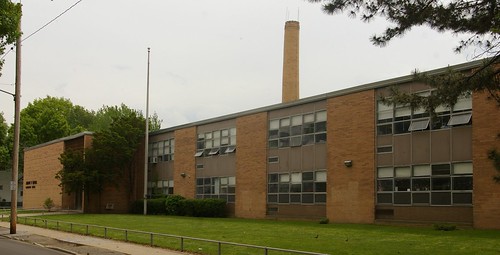
Joseph F. Landis
10118 Hampden Avenue
Built 1963.
This structure may likely have similar issues to some of the other structures erected by the CMSD in the 1960s.
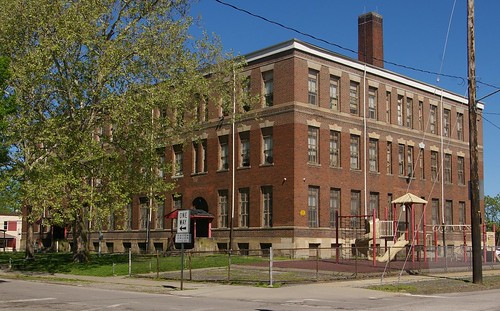
Mound
5405 Mound Avenue
Built 1904. Frank Seymour Barnum, architect.
This school was built on the site of a prehistoric earthwork, which I covered a while back.
Phase IV
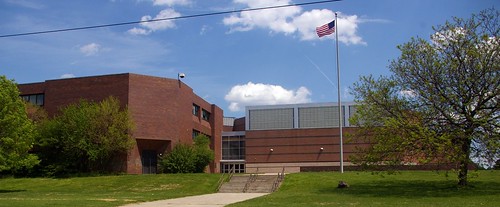
East High
1349 East 79th Street
Built 1975.
This structure, as work of the time goes, isn't that bad. Further, it's on a 13 acre site, which ought to be quite an asset.

Kenneth W. Clement
14311 Woodworth Road
Built 1976.
This school is an interesting structure.

South High
7415 Broadway Avenue
Built 1968.
As with East High, one of the big advantages of South High is large lot that it was built on.
It is hard to fault the Cleveland Metropolitan School District for demolishing the schools that are to be rebuilt. The state requires that if the estimated rehabilitation cost exceeds 75% of the cost of new construction, that a new building must be built. This is because, as you surely know if you've ever fixed up an old building, costs are always higher than estimated. The school is in a difficult financial situation, and can't afford to give up the state portion of the funding for these projects. If we find this to be problematic, we need to work for change at the state level.
For the 20 schools that will not be rebuilt, the CMSD will spend $4.2 million dollars on demolition, about a third of the cost. The state will pay for the other two thirds. This works out to $210,000 per school.
Many of the schools need considerable work to be safe and healthy learning environments. I don't dispute that. As these assessments show, many of them haven't received the maintenance that they need for years. However, there are many ways that they could be reused that don't require the expense that the state sets for new learning environments.
CMSD Chief Operating Officer Patrick Zohn has stated that the buildings will be demolished so that they don't become eyesores and so that the land can be redeveloped. Have we not learned this lesson from our downtown, where parcels were assembled for redevelopment, only to end up as surface parking? Even if the district has to spend $150,000 on each of these buildings to get someone to take it, they still come out ahead.
Further, at the very least, there needs to be a comprehensive architectural salvage plan. Many of these buildings posess great exterior detail. Further, due to the lack of maintenance, they have often retained many of the original interior fixtures - this includes marble-lined bathrooms in several of the schools. Salvaging the material and reselling it, likely through a third party, would offset the cost of the demolition.
There are plenty of great buildings here, buildings that could be reused in any number of ways. Later in the week, I'll address one of these. We can't simply assume that the best use of these properties is as vacant land. Some probably are too far gone to be useful. This doesn't mean, however, that they should all be bulldozed without a good faith effort being made to find new owners for them.




It is sad to lose so many. I hope they won't come down like this one did: http://realneo.us/content/cleveland-clinic-shame-shame-shame
ReplyDeleteSpeaking of architectural salvage: http://realneo.us/content/parapet-market
I agree that CMSD should have an architectural salvage plan at least. CCF seems to have glossed over that "green", "thrify" sort of planning with their demos.
I completely agree with you. What is so difficult to explain to a lot of people, is that old things have value. That's the problem. BUT people actually want that tile, those light fixtures, that glass and will pay money for it!...to me it feels like what's going on is, bulldozers are driving through buildings filled with cash. My high school, Berea High School, built in 1929 is most likely going to be demolished and made into a parking lot for Baldwin Wallace by 2012. It's such a neat building. It has gargoyles...
ReplyDeleteThis demolition money could be much better spent getting rid of more dilapidated houses. These old school buildings contain higher embodied energy and are much more reuseable than poor quality houses... They tend to be fireproof, robust structures in comparison to the inefficient, repetitious and slapped-up frame houses around them. They could be centerpieces of new development, instead, they'll be empty lots.
ReplyDeleteI think that the demoliton of East High and South High is a disgrace for both neighborhoods. Unless there are plans to put something in those spaces immediately, it's going to make those neighborborhoods look even more depressing.
ReplyDeleteNot sure how tearing down historically significant structures fits into the overall sustainable Cleveland plan by the mayor, or are the tow offices not talking to each other. Once a building is gone, it is gone and cannot be brought back-ever! In Portland, a private company bought an elementary school and created an awesome space. It is a hotel (classrooms for suites) with community gym, a busy restaurant, three additional bars, and a movie theater/pub. This is the inventive kind of thinking that we need here in Cleveland!
ReplyDeleteSickening....
ReplyDeleteI was really to learn that Euclid Park Elementary School was torn down a few years ago. I went there and it was a good school and such a nice setting on the hill.
ReplyDeleteDoes anyone remember the old Broadway School - or Holy Name Elementary School that was on the corner of Worley Ave and Broadway? It was torn down I believe in the late 70's - early 80's. I'd like some info on that school - there is only one picture of it on Cleveland Memory.
ReplyDeleteI heard that the school was dismantled and built somewhere else. church is still there.
Deletestill there.....
Deletehttp://www.holyname-elementary.org/
still there.....
Deletehttp://www.holyname-elementary.org/
still there.....
Deletehttp://www.holyname-elementary.org/
I remember the building you are referring to. It was approximately five stories tall and demolished back in the 80's. Apartments were built on the property. I used to catch the bus at the corner on Broadway in front of this building while attending A.B Hart. The Holy Name these other folks are referring to is down near Harvard ave.
DeleteAlmost all those buildings would make great living spaces, I used to live on Random rd in Little Italy and the beautiful apartments next to me were in a former school building. Very sad! They should at the very least take the time to AUCTION OFF THE OPPORTUNITY to go through and salvage what it salvageable. Cleveland CAN have what other cities have but unfortunately the people that can make that happen won't do it unless there is something in it for them. Think about it, if you have vacation time would you spend it in Cleveland? Most people GO SOMEWHERE else! All anyone has to do is watch the Travel Channel to see where people are going. When was the last time you saw Cleveland on the Travel Channel? Exactly... if we don't have year-round reasons to visit Cleveland, why would anyone from out of state come to visit? If you build it they will come....but try rehabbing first!!
ReplyDeleteI remember watching them build John W. Raper and attending school there. I went to Charles Dickens and Alexander Hamilton also! I am sick to my stomach!!!! This is a travesty!!
ReplyDeleteI went to Henry W. Longfellow and given the opportunity, I'd love to buy it
ReplyDeleteI went to Henry W. Longfellow and given the opportunity, I'd love to buy it
ReplyDeleteI went to East high from 2006-2009 & I loved that school it really breaks my heart thats it going to be torn down...I would love to have something from the building for memories !!!
ReplyDeleteWow, product of the old South High (AB Hart) and first graduating class of the new South High. Both of my parents also graduated from South. I also taught in Cleveland Public Schools and was present when a man named Judge Batisti ordered "desegregation".
ReplyDeleteSorry, but it ruined one of the best public school systems in the country. So, so sad. Not only was there White flight, but Black. You see we all want the best for ALL of our students, and as we have found out, "desegregation" was wrong. Living & teaching in Ca since '87 and sorry, I can't support our public schols anymore.
Always some one else fault so you say it we go back to the old ways every thing would be jim
ReplyDeletedandy Jim Crow is loud and Well.
South high school was a good school-graduated 1994 with honors. Then it was not that bad, it is after I graduated when I felt it went bad. Good times at this school and always will be for me.
ReplyDeleteI have seen schools redeveloped into housing for seniors, disabled and low-income. Revitalization is needed and would be a compliment to the communities in which these beautiful schools are located. This may be costly but in the long run, would provide additional housing for the homeless and low income families. STABILITY and REVITALIZATION
ReplyDeleteWhen the new South HIgh opened it was dubbed the most beautiful, high tech school in Ohio. Graduated from South in '69 and taught in CPS (as it was known then) for 6 years. Terrible, terrible shame what has happened to Cleveland. Forced busing did not help the system but contributed to it's demise.
ReplyDeleteSouth was a beautiful school. Went there the second year it was opened. Gym floor wasn't finished yet. Still have my schedule..the book they gave you with a map of the classrooms. Still have my treasure chest of item I kept when I graduated. South High Flyer notebook pad you could buy in the school store, wrestling book, home coming book. Met my future husband of 40 years at the school. Great teachers...great students. Times have sure changed. Still get warm fuzzies thinking about it and looking at my memorabilia.SIGH...Go Flyers!
DeleteI don't think forced busing was as much an issue as was deindustrialization of the Cleveland Metro area. The erosion of the tax base and smaller family sizes also had major impact. Every school I attended in Cleveland were very ethnically mixed, from elementary schools like the old Doan and Oliver Wendell Holmes to John Adams High, of which I graduated from in 1965. It is depressing seeing the impact on neighborhoods and the city as a whole when schools close but I guess it's a matter of using existing tax revenues where they can be maximized.
ReplyDeleteMy Dad was Assistant Principal of Mount Pleasant until he died in 1983. He passed away at the age of 42 of a heart attack.
ReplyDeleteI attended the old A.J.Rickoff school third thru sixth grade. Had a wonderful teacher there, Mr. Rose. Best thing that ever happened to us, devoted, determined,dedicated to showing us that education wasn't just about abc's and 123's, she broadened our focus with french, we learned to play chess, not to mention arts, crafts and trips.She taught us OUR history on the side, on her own time.Thank You for caring.
ReplyDeleteI also went to AJ Rickoff. That school was torn down because the roof caved in. At least they had a legitimate reason to rebuild it. Unlike some of the other schools. I still haven't gotten over them tearing down Corlett Elementary to put the NEw Charles Dickens there. I am still bitter that they chose to rebuilt John Marshall instead of renovating it like they did John Hay.
ReplyDeleteI was in the first graduating class of South High School in 1969. It was a beautiful school with its indoor courtyards, state of the art auditoriumn and stage, and one of the first computer labs in the state. We started before it was totally finished but were still impressed. So sad to see it go.
ReplyDeleteIt is a matter of values and priorities. If you don't value something you won't take care of it, If it is not a priority you won't do anything. We are too busy in our society valuing "quick, easy, and cheap", and we want it all right "now". And we give far too much credit to human intelligence. Not valuing these buildings and tearing them down is / was short sighted, selfish, and down right stupid.
ReplyDeleteThe majority of these school buildings are better built than the buildings that have or will replace them. These buildings are part of our heritage and our culture - all disposable in today's America. Shame on us. We will not build buildings as nice as this again. The architectural detail is exquisite and we don't add that to any new buildings. All of these buildings should be taken off of the demolition list and an adaptable reuse should be found for all for them. It is clear to me that the educators and bureaucrats on the board of education that decided the fate of these buildings did not learn much when they were students in them. They should give up their position to persons wit a greater sense of responsibility and more creativity.
ReplyDeleteI went to Miles School in the 1950's. Great teachers in those days....Mrs. Donner, Alice Morey, Jack Durell ( gardening ), Mrs.Losch ( principal ) , Ms. Sarazen, Mrs. Bertoli, Mrs. Byrant and the best of all Helen Wycoff. I somehow remeber Mrs. Wycoff telling us stories of what she remembered of being a 5 year ld girl in the Oklahoma Land Rush of the 1890's. She taught 5th and 6th grade Major Work which was a gifted program back then.
ReplyDelete